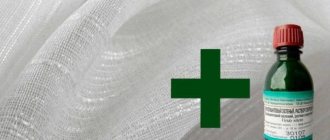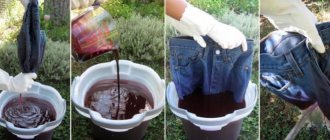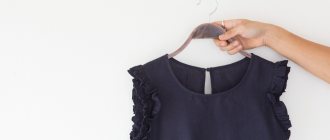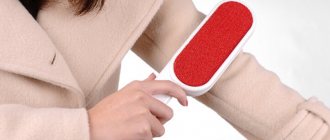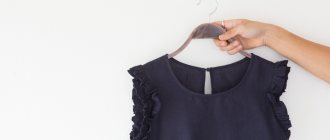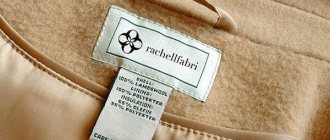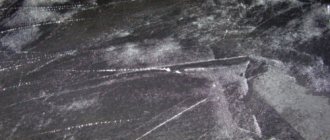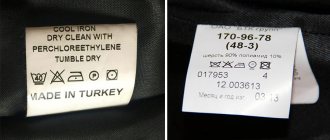Before painting
Before you start dyeing your coat, you should weigh the pros and cons, as there are always risks in this procedure. Are you sure you can dye your coat at home or should you take it to the dry cleaners where they can dye it themselves?
Then we proceed as follows.
Determining the composition of the fabric
Most often, the final result depends entirely on the quality of the material from which the coat is made. There may be the following options:
- Natural fabrics. They are best suited for repainting a different color and the risk of failure is minimal.
- Mixed. In this case, the original version will turn out to be somewhat paler than you expected.
- Synthetic. They stain poorly or not at all. Therefore, it is better not to take risks.
Important! Very often, careless manufacturers indicate on the tag the composition of the fabric from which the product is made. Please take this into account. And to protect yourself from surprises, try to initially dye a small piece of fabric that always comes with any item.
Deciding on the future color
It is best not to radically change the color. Choose the same or a few shades darker. For example, if your coat was red, then you can dye it the same or burgundy. For the experiment, that same spare piece of fabric will again come in handy.
How to update a coat
If your favorite coat has become a little worn out during wear, but the material is well preserved, you can revive it and make it an exclusive model of your wardrobe. You just need to thoroughly clean it, replace some parts and update decorative elements.
Instructions
1
Wash
coat
. Do not machine wash to prevent the product from becoming deformed. You can treat the fabric with carpet cleaner according to the instructions, paying special attention to the cuffs, sides of the coat and hem. Dry thoroughly on a hanger. First make sure that the product does not cause fabric shedding. If the material contains a high percentage of wool, it is better to use dry cleaning services.
2
Treat an old coat with a pellet machine. This device costs from two hundred rubles and runs on batteries. Use it to remove pellets on the sleeves and side parts of the coat. If the coat is made of textured bouclé fabric, remove the formed pills by hand; this is painstaking work, but the result is worth it.
3
Dispute worn out faded buttons. Buy new ones, similar in size and sewing method. Give preference to bright buttons that contrast with the color of the coat fabric, and sew them in the right places. If decorative loops, metal and plastic buckles, leather and substitute inserts are sewn onto the coat, it is better to replace them with similar new parts.
4
Shorten your coat. This fundamental change to the model is aimed at
achievement
two goals. Firstly, you change the style, the coat can be
wear
with others
trousers
and skirts. Secondly, the hem of an old coat often looks shabby and unkempt, so even removing 2-3 cm will hide the true
age
products. If you do not have the skills to process hems, contact a familiar dressmaker or atelier.
5
Decorate your coat with an unusual brooch or decorative pin, pin a textile flower on the lapel, and you will see how the product “comes to life.” Experienced needlewomen can decorate the collar and chest area with appliques made of leather, suede, or cord.
Sources:
- updating an old coat
- Fashion fall 2021: updating your fall wardrobe
Basic painting rules:
- Only clean items should be dyed. Wash the product in advance, and immediately before the procedure, soak it in warm water.
- Painting the coat should be carried out following the instructions indicated on the packaging of the dye mixture.
- After completing the procedure, the product must be rinsed until the water becomes completely clear.
Important! The final rinse should be done by adding a few tablespoons of vinegar to the water.
How to dye coats and other outerwear at home
Over time, the coat changes color, it becomes pale, and spots appear that are difficult to get rid of. If your plans do not include buying a new piece of outerwear, do not despair, the situation can be corrected and you can dye your coat yourself at home. It will not take much effort and time, and there is no need to take it to the dry cleaner. The main thing is to strictly follow the instructions.
What needs to be prepared for painting
Before you begin the dyeing process, you should find out what material the outerwear is made of. The final result largely depends on this. Manufacturers use the following types of fabric for sewing:
- Natural. For painting this is the most acceptable option.
- Synthetic. Such materials are practically not paintable. The risk may not be worth it.
- Mixed. As a result of the procedure, the clothes acquire a paler color.
It is important to know! Sometimes the coat label indicates the fabric composition that does not correspond to reality. It is recommended to paint the patch first, it is always attached to a new product.
There are certain coloring rules that must be strictly followed:
- the coat must be clean;
- before the procedure, it is soaked in warm water;
- After completing the procedure, the product is thoroughly rinsed until the water is clear.
If you decide to dye your coat a different color, you should buy the desired shade of dye, a special brush and vinegar in advance.
Correct procedure
The coat is weighed to determine the required amount of paint and the instructions are carefully read. It says how much dry powder is needed for a certain weight. After this, you can proceed directly to the staining process, performing the following steps sequentially:
- Using a rubber brush, outer clothing should be cleaned of dirt. It is advisable to remove existing stains; not all dyes are able to hide them.
- The paint must be diluted in boiled water, and a bite must be added to the resulting solution. Its content must correspond to the quantity specified in the instructions.
- Follow the algorithm written on the packaging.
Dry painted items at room temperature away from heating appliances. They should not be exposed to direct sunlight. It is advisable to spread the coat on a horizontal surface, placing it on a sheet or hanging it on a hanger. You need to make sure that no smudges appear on it. By strictly following the steps indicated in the instructions, you will not get an unexpected result, and the coat will acquire a second life.
How to dye a coat?
In order to repaint a coat a different color, you need the following equipment:
- Vinegar;
- Water;
- Rubber brush;
- Dye for clothes.
Important! You can determine the required amount of paint by weighing the coat. After this, find this parameter in the table on the package.
- Comb the product with a rubber brush.
- Dilute the dye in warm boiled water.
- Vinegar should be added to the resulting solution (the required amount is also indicated in the instructions).
- Next, you need to follow all the recommendations indicated on the packaging by the manufacturer.
- After finishing dyeing, the coat should be hung to dry outside or in a room with good air circulation.
Important! The only option when you can paint a coat a radically different color is the light color palette of this product. That is, if the coat is white or beige, then you can dye it either blue or pink.
Is it possible to dry-clean a coat a different color? How to dye a coat
Repainting a coat in a different color is sometimes the only way out if the current appearance of the product has deteriorated greatly, or the color has gone out of fashion. In order to repaint a coat, it is not at all necessary to take it to specialized dry cleaners. You can achieve the desired result at home.
Redying a coat requires certain knowledge about the characteristics of a particular material. If you doubt your abilities, it would be better to trust the professionals.
The easiest way to paint a light coat at home is one of the dark shades: blue, brown, black.
Before you begin redying, check the coat's label to ensure you know exactly what material it is made of. Typically, such items are made from wool, tweed, cashmere or wool blend fabric. To recolor such items, purchase wool dye. It is sold in special household chemical stores.
Before dyeing, it is necessary to clean the surface of the clothing using a rubber brush or a damp cloth. If there are stains on the fabric, do not forget to remove them in advance.
In order to determine the required amount of dye, you need to weigh the coat, and also carefully read the dyeing instructions (on the dye packaging). Usually it indicates the required amount of dry powder for a certain weight of the product.
Dilute the dye in boiled water. Add the required amount of vinegar to the resulting solution (this is stated in the instructions). After this, follow the step-by-step recommendations indicated on the dye packaging. To fix the dyeing result, rinse the coat in a solution of 1-2% vinegar. Once the operation is complete, hang your clothes out to dry.
If the dye lies unevenly on the surface of the product, then try again in accordance with the algorithm described above. If you were unable to redye the fabric a second time, choose a black dye.
Once the coat is dry, run a white cotton swab over the surface to make sure the paint has set.
Repaint it black
In order to dye a coat black at home, you will need the following equipment:
- Wooden spoon with long handle;
- Laundry soap;
- Salt;
- Water;
- Soda;
- Washing powder;
- Fabric dye.
- Wash your coat using powder or a solution of soap and soda.
- Remove all buttons, snaps and other decorative items. This is necessary so that the painting is done evenly and there are no bright spots left.
- Prepare the dye according to the instructions.
- Wet the coat in warm water and quickly transfer it to a container with dye.
- Next, the solution should be heated almost to boiling. Adhering to this temperature regime, you should constantly stir it for about 20-25 minutes. This is necessary for uniform coloring.
- Pour in a saline solution in the proportion of 2 tablespoons of salt per 2 liters of water.
- Stir for about 20 minutes and remove the product from the dye solution.
- First, you need to rinse in warm water, gradually lowering the temperature to cold.
Dyeing a coat in a washing machine
Using a washing machine greatly simplifies the process of dyeing a coat. Today, this is one of the most popular and simplest methods used to change the color of clothes. Therefore, in order for the initial result to please you and the product to be colored evenly, you must adhere to the following rules:
- The diluted ready-made color mixture should be poured directly into the drum.
- The temperature should be no more than 60-80 degrees. The longest cycle should be chosen. This is necessary so that the paint is distributed evenly.
Important! After you have completed the dyeing process, the washing machine should be run empty. This is necessary in order to completely eliminate any remaining paint that may remain.
- After painting, the product should be rinsed in a vinegar solution.
- If the dye is applied unevenly, and the color turns out to be streaky, then the operation should be repeated again.
- If the second attempt fails, the only way out is to paint the product black.
- After the coat has dried, it should be wiped with a dry cloth or cotton pad.
Important! After dyeing clothes in a washing machine, it is not recommended to wash white items for the first time.
How to dye a coat
If your coat has lost its former brightness or its color no longer suits you, try repainting the product. To do this, it is absolutely not necessary to take your outerwear to the dry cleaner, because you can carry out all the necessary manipulations yourself.
We suggest you familiarize yourself with How to wash coffee on different fabrics: fresh stains, old ones
- dye; - rubber brush; - vinegar; - water.
Posting sponsor P{amp}amp;G Articles on the topic “How to repaint a coat” How to clean a sheepskin coat How to dye a down jacket How to wash a down jacket with padding polyester
Before you begin the process of transforming your coat, decide what you would like this wardrobe item to look like. The lighter the current shade of your outerwear, the easier it will be to dye it a different color. The easiest way to work is with fabric in white, beige and other related shades. If your coat is black, the only way to properly repaint the product is in some rich dark color: burgundy, red, blue, dark green, etc.
First of all, you will need to prepare your coat for painting: thoroughly clean and remove stains from its surface (if any). Buy suitable paint for clothes and a rubber brush. You will also need vinegar and water.
To buy a good paint that is suitable for your product, carefully look at the coat label. Usually there is information about the properties of the clothing fabric (as a rule, coats are made from wool, tweed, cashmere, wool blend). It is better to purchase paint at a special household chemicals store.
https://www.youtube.com/watch?v=SzplPlz0VPQ
To measure the amount of dye needed, weigh the coat and then read the instructions for using the chemical. The technical documentation must specify the volumes of dry product designed to dye a certain mass of clothing.
If your coat is made of wool, dilute the dye in boiled water. Then add the required amount of vinegar there (this information is also presented in the instructions). Continue to act according to the algorithm specified in the accompanying document attached to the dye.
If you want to consolidate the result, rinse the product in water mixed with a 2% vinegar solution. Once the dyeing process is complete, air dry the coat. To do this, use so-called “hangers”, which will prevent clothes from deforming during drying. After dyeing, wash outerwear by hand at minimum water temperature. How simple
Useful tips and tricks
So that everything works out for you, and the repainting process does not cause unnecessary trouble, we offer you some useful tips:
- Try to determine the required amount of dye as accurately as possible.
- The container in which you prepared the coloring solution is no longer suitable for cooking and storing food.
- Always wear gloves.
- If the coat is wool, then you need to dissolve the paint in very hot water.
- If you plan to alter this item in the future, then you can tear it apart and paint it in parts.
- To prevent the product from burning during the process, you can put a wooden board on the bottom of the container.
Video material
In order to give a second life to your outerwear, you will not need a lot of physical effort and material costs. With a little patience, you will end up with a completely new coat, albeit one with “old holes.” But only you will know about this!
The hero of the old film wanted “the same, but with mother-of-pearl buttons.” It happens that the thing you like is slightly different from what you need - for example, in color. And in general, products tend to lose their original color, fade in the sun or wear off over time! “BUBBLES” will help solve these and other problems with its textile dyeing service. A team of professionals will take on the task of repainting things and do it the way you want! After all, our goal is not a single dissatisfied client. And if real “BUBBLES” see the goal, there are no obstacles for them!
Dyeing clothes at a dry cleaner. Price
The network of Moscow dry cleaners "BUBBLES" will help you renew or refresh your favorite things that have lost their color from only 500 rubles. The “BUBBLES” team can handle dyeing any textile, leather and suede items at an affordable price. If it is inconvenient for you to bring things to us, then we can come ourselves at a time convenient for you, paint them and deliver them back! We strive for the impossible so that you get the best! “BUBBLES” will give new life to your favorite things in a short time. Call right now or leave a request for painting things online!
In the modern world, when meeting and communicating, people first of all pay attention to the appearance of the interlocutor, his clothing. You can create a chic appearance with the help of an expensive suit and jewelry, but in winter all this is hidden under outer clothing, for example, a coat. During wear, it may get dirty or lose color. Of course, the easiest way is to buy a new one, but not everyone has this opportunity, so you need to start restoring the item by painting it at home. How to do it? Let's figure it out together.
Is it possible to paint a coat with suede paint? How to dye a suede jacket
Suede is genuine animal leather subjected to special processing. It is distinguished by its softness, elasticity and aesthetic appearance. Suede is one of the delicate materials and requires careful care. A suede jacket gets dirty easily and quickly allows moisture to pass through, causing the product to lose its color and presentation.
How to return the color of your favorite thing?
- Carry out the coloring procedure yourself. This can be done using wool dye, spray paint and liquid dye. The listed products are sold in every shoe store. However, it is worth considering that before painting any product, it must be cleaned, and thoroughly enough, otherwise, when applying paint to the surface, there is a risk of permanently ruining the jacket.
If dyed incorrectly, you can ruin the item.
- Entrust the product to dry cleaning professionals. In dry cleaning, before starting work, the product is cleaned from various types of contaminants in an organic solvent, and only then the dyeing procedure is carried out. It involves uniformly painting the item in the color chosen by the client. Using modern equipment, ultra-resistant dyes and fixatives, a “novelty effect” is achieved.
When painting on your own, problems may arise, and the most important of them is the instability of the applied dye, or uneven coloring and different shades of the product after drying.
Advantages of our services
- After cleaning and subsequent dyeing, you receive a clean product both outside and on the lining, without dirt or foreign odors;
- after dyeing, the product does not lose its color for a long time;
- the paint used is resistant to adverse weather factors (rain, sun rays);
- optimal prices for all types of services;
- and most importantly, you have transferred all the risks onto the shoulders of professionals!
By contacting Eurodry Cleaning, you have the opportunity to choose the desired color if you are not satisfied with the current one. When painting, all the properties of the material are preserved.
Still have questions?
Our technologist is ready to answer them: Call: 8 (4872) 28-25-20. You will see prices and addresses of dry cleaners below.
Preliminary procedures
Before you start dyeing your coat, you need to assess the risks and make a firm decision whether it is worth doing. If there is no way out, then you need to act according to certain instructions. First of all, you need to determine the composition of the fabric, because it determines the quality of the work carried out in the future:
- Natural fibers - they can be dyed any color.
- Synthetic fabrics - this procedure is not suitable for them, since it is impossible to achieve the desired result.
- Combined - the shade of the dyed coat will be slightly lighter than expected.
Important! Unscrupulous manufacturers may lie and indicate information on the tag that is not true. In order not to spoil the item, you need to do the procedure in a small and inconspicuous area.
As for the choice of color, experts do not recommend bold experiments, leaving the coat in approximately the same color as it was originally. It is best to choose a color several shades darker, so that the experiment will end successfully and the item will delight you with its attractive appearance.
Painting rules
- Before the procedure, the coat must be washed in a washing machine and dried. Immediately before painting, it must be moistened in warm water.
- Painting is carried out according to the instructions on the paint package.
- After the procedure, the item must be rinsed in water until it stops changing color.
Important! To fix the color during the last rinse, you can add a little vinegar to the water.
Correct procedure
The coat is weighed to determine the required amount of paint and the instructions are carefully read. It says how much dry powder is needed for a certain weight. After this, you can proceed directly to the staining process, performing the following steps sequentially:
- Using a rubber brush, outer clothing should be cleaned of dirt. It is advisable to remove existing stains; not all dyes are able to hide them.
- The paint must be diluted in boiled water, and a bite must be added to the resulting solution. Its content must correspond to the quantity specified in the instructions.
- Follow the algorithm written on the packaging.
Dry painted items at room temperature away from heating appliances. They should not be exposed to direct sunlight. It is advisable to spread the coat on a horizontal surface, placing it on a sheet or hanging it on a hanger. You need to make sure that no smudges appear on it. By strictly following the steps indicated in the instructions, you will not get an unexpected result, and the coat will acquire a second life.
How to dye a coat at home?
First of all, you need to prepare equipment that will be useful during the procedure, namely:
- Dye.
- Rubber brush.
- Water and vinegar.
Important! To determine the amount of paint that is needed, you need to weigh the coat and find the appropriate value in the table that comes with the paint.
The staining procedure includes the following points:
- Comb the clothes with a rubber brush.
- Dissolve the paint in warm boiled water and add a little vinegar.
- Dye the coat according to the instructions for use.
- Hang to dry on the balcony.
- Rinse.
How to dye synthetic fabric at home. How to dye synthetic fabric
Sometimes it happens that a new item does not match the color of the rest of your wardrobe. And the old things, which are still quite durable, are a little boring. In this case, you can try to dye your clothes a different color or refresh the previous shade.
You will need
- – dye;
- – washing powder;
- – 25% ammonia;
- - salt;
- – water.
Instructions
1
Before dyeing a thing, you need to determine the composition of the fabric. It is usually indicated on the tag on the reverse side of the product. If there is no such tag, cut off a small piece from the stock and set it on fire. When natural fabrics burn, they emit the smell of burnt hair or paper. Synthetic fabrics burn without smell, except for silk acetate, which smells like vinegar.
2
Products made of nylon and nylon can be painted with aniline, acid and disperse dyes. Some disperse paints are suitable for dyeing silk acetate, lavsan and nitron. It should be taken into account that when dyeing colored products, the shade turns out darker and more saturated than indicated in the annotation for the dye.
3
Any items should be washed before painting. Rinse thin items in a solution of ammonia 50 g per 10 liters of water, then successively in clean warm and cold water. Soak the faded fabric for half an hour with washing powder, wash and rinse in a solution of ammonia, then in clean water. This pre-wash is needed to remove protective impregnations from new items, and stubborn dirt from old ones.
4
For coloring, it is better to choose enamel dishes. It should be clean, without chips and scale. Weigh the product to determine the amount of dye needed. To soften the water for preparing the solution, add baking soda to it, let it settle and filter the precipitate. If you are using dyes for wool and cotton, prepare the solution according to the instructions, then add 2 tablespoons of vinegar essence and 3 tablespoons of salt to it per packet of dye.
5
Synthetic fabrics cannot be boiled, as they are deformed under the influence of high temperatures. Heat the solution to 40 degrees and lower the fabric there for 15-20 minutes. Then take out the product, let the solution drain, rinse until the water becomes clear, wring out without twisting and hang on hangers to dry.
6
Lavsan fabrics are difficult to dye. If you are going to dye a mixed fabric, such as wool and dacron, do a test dye on a piece of spare fabric first. Be prepared to get a melange effect.
Painted black
To make the coat black you will need:
- Dye.
- Washing powder.
- Salt and soda.
- Water.
- Laundry soap.
- Long wooden spoon.
- Wash the item in soapy water with the addition of baking soda.
- Remove decor (studs and buttons).
- Dilute the dye with water according to the instructions.
- Soak the coat in warm water and place in the solution.
- Place on the stove and bring to a temperature of 90-95 degrees. Maintain temperature and cook for 20 minutes, stirring the coat with a wooden spoon.
- Add salt (a tablespoon per liter of water) and cook for another 20 minutes.
- Remove the coat from the solution and rinse alternately in warm, regular and cool water.
How to dye a coat in a washing machine?
You can simplify the procedure by using modern technology, for example, a washing machine. When using it, the procedure for dyeing a coat is as follows:
- Pour the color mixture into the drum.
- Set the temperature from 60 to 80 degrees and turn on the longest operating cycle.
Important! At the end of the cycle, you need to remove the coat and run the washing machine idle, clearing the drum of paint. You also need to remember that after this procedure it is not advisable to wash white clothes for the next few days.
- Rinse the coat in vinegar solution.
- Repeat if unsuccessful.
- Paint it black if all your efforts were in vain.
- Let dry.
- Wipe with cotton wool.
How to dye a coat in the washing machine. Dyeing clothes in the washing machine
Don't want to part with your favorite jeans or trousers, but they look faded? Then we suggest you paint them. This procedure scares many, but if you paint in an automatic machine, then there is nothing difficult. This article will describe in detail how to do this correctly, what paint to choose for clothes in the washing machine, and will it harm the equipment?
The procedure for dyeing clothes in a washing machine
Before you dye your clothes in the washing machine, you need to wash them well. Only after this do we perform the following steps in sequence:
- Take fabric paint and dilute it according to the instructions. If the dye is liquid, then pour the required amount into a measuring container.
- Pour the paint into the powder tray.
- Place the wet clothes (jeans, coats or T-shirts) that you want to dye into the drum. Wet things stain better.
- Depending on the model of the washing machine, we select a washing mode in which the water in the drum is heated to a temperature of 90-950C. The washing time should be at least 30 minutes. You can read more about possible functions in the article Functions and modes in a washing machine
Note! Longer washing will provide better dyeing of the fabric, its color will be more saturated.
- You can set an additional rinse to ensure that the excess dye is thoroughly rinsed out of the clothes.
- We start the wash and wait.
- Now we select the washing mode in cold water and wash the dyed clothes with powder. Cold water will set the dye into the fabric. You can rinse the item by hand, but be sure to use cold water.
- At the end of the procedure, the washing machine must be cleaned of paint. To do this, start the washing process with the addition of one glass of bleach. You can put old and unnecessary things. If there are none, then you need to start the car in idle mode. This procedure is done so that the remaining dye particles are washed out of the machine and do not spoil the items during the next wash.
So, the item is painted, all that remains is to dry it, and you can put it on again.
Does paint harm the washing machine?
Having heard that clothes can be dyed in a washing machine, some may wonder what will happen to the machine after such a procedure. The question is quite reasonable, let's try to answer it. After the usual procedure of dyeing clothes with fabric dye, nothing will happen to the machine, since the dyes do not contain aggressive chemicals. It is much more dangerous to pour vinegar or other acids into the car, which can lead to the destruction of rubber parts.
But it's not that simple. After such a procedure, paint particles may remain in the machine, which will require additional cleaning and rinsing. If you neglect this, then after the next wash you can remove stained items from the machine. That’s why it’s worth washing something you don’t need in it at least once.
Dyeing jeans and fabrics in a machine has a big advantage. You don’t have to constantly stir and turn the product with your hands when working with paint and boiling water. All this work is done by the technique, thereby ensuring uniform coloring. However, the final decision is up to you on how to dye your jeans in a washing machine or in a basin.
Dye for dyeing clothes
In order to dye clothes at home, you need to choose a suitable paint. The most important thing to consider is the type of fabric. If you are not sure what fabric the clothes are made of, then purchase universal dye. Let's look at the most common dyes.
- Surf dye is a universal dye suitable for natural and artificial fabrics such as cotton, wool, nylon. The palette of this dye includes 10 colors. One packet of paint is designed to dye 0.5 kg of fabric.
- Paint under the Simplicol brand is a paint intended for dyeing natural fabrics, as well as clothes consisting half of synthetics. Manufacturers of the dye warn that it is not suitable for dyeing wool, silk, cashmere, polyamide and polyurethane-coated clothing. There is a special dye marked for silk and wool. Note that this paint, unlike the previous one, contains a dye fixative. It is suitable for dyeing in the washing machine.
- Paint under the Fashion Color brand is a fabric paint made in Germany, suitable for dyeing items in the washing machine. One package of paint is enough for 1.5 kg of clothes.
Important! The paint color declared by the manufacturer will be original only when dyeing white clothes; in other cases the tone will be different.
Alternative dyeing methods
If you still haven’t decided to dye it in the washing machine, you can try dyeing the product manually using one of the following methods.
The first method is to dye fabrics with natural dyes. Natural plants are used as such dyes. For example:
- Orange color is given by: carrots, plantain seeds, onion peels.
- Brown color is obtained from oak bark shavings, coffee, tea, nut shells, and dandelions.
- Berries give pink color: victoria, cherries, raspberries.
- Blue dye is found in cauliflower leaves, cornflower petals, blueberries, irises, and dark grapes.
- Red with a brownish tint will be obtained when stained with pomegranate juice, elderberry, beets, and hibiscus.
- The black color comes from ink nuts and blackberries.
- Green color is characteristic of sorrel roots, spinach leaves, lilac flowers, and yarrow.
- Yellow is obtained from bay leaves, calendula flowers, dandelions, St. John's wort, narcissus or turmeric.
Before you paint an item, you need to treat it with a fixative, which will help the paint adhere to the fabric. If the dye is berry, then use a salt solution as a fixative; take 125 grams of salt per 2 liters of water. If the dye is vegetable, then a solution of vinegar diluted in a ratio of 1:4 is used as a fixative, where 4 parts are water.
When the plant material is collected (leaves and berries must be ripe), it is cut into small pieces and placed in a large container. In this container you will dye clothes. Pour the dye with water and bring to a boil, then simmer the solution over low heat for about an hour.
Please pay attention! You need 2 times more water than dye.
After boiling, filter the water from the leaves or berries and place the product in it. We boil the clothes for an hour, turning them over periodically. The longer the item is in the water with the paint, the more intense the color will be. After the procedure, it is necessary to rinse the product well in cold water and air dry.
The second method involves the use of chemical dyes. To do this, pour water into a large container and boil. Next, add the fixing solution to the water. For cotton products, use salt at the rate of 1 cup per 3 liters of water, for synthetics, white vinegar, 1 cup per 3 liters of water.
Now add the dye, stir the water until it is completely dissolved. Next, put the clothes in the container, and, stirring for half an hour, simmer over low heat. All that remains is to rinse the product in plenty of water. You can rinse with hot water first, and then gradually reduce the water temperature. Rinsing in ice water will set the dye to the fabric.
Some tips for coloring
In conclusion, we offer some useful tips that will help you avoid common mistakes when dyeing clothes at home.
- Berry and vegetable dyes dye silk, wool and cotton better.
- It is not recommended to dye clothes made of polyester, acrylic, elastane, as well as clothes that are washed in cold water or only cleaned.
- Before the procedure, prepare napkins in case you accidentally spill paint. Wear gloves and an old robe.
- Strictly follow the instructions included with the dye.
- When dissolving paint, do not inhale it. Be sure to ventilate the room during and after work.
Good luck with your experiments with dyeing textiles in the washing machine!
